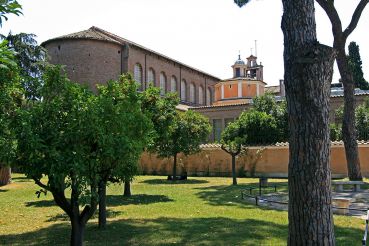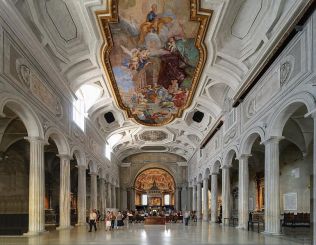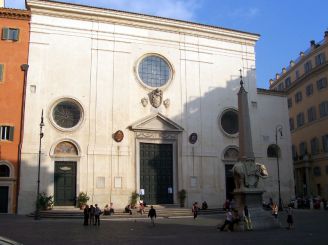Basilica of Saint Sabina, Rome

Basilica of Saint Sabina in Rome (Basilica di Santa Sabina all'Aventino) is one of the oldest churches in the city. It was built in the style typical for the later Roman temples and does not shine with decorations. But the church is the main abode of the Catholic Dominican order. A long history has contributed to the emergence of interesting legends.
History of the church
The church was built in the period of 422-432, by the priest Peter from Illyria. Construction was carried out on the site of the house and at the same time above the grave of St. Sabina, who was the wife of the Roman senator during her lifetime. There was the pagan temple of Juno on the hill nearby, and 24 columns were taken from it for its construction.
At the initiative of Pope Honorius III, the church was transferred to the newly created Order of the Dominicans in the Middle Ages, in 1219. At the same time the bell tower was built. In 1287 it became the place for the conclave of the Cardinals for the election of a new Pope.
In 1587, the church was restored according to the project of Domenico Fontana, and in 1643 Francesco Borromini took part into the creation of the interior design. In 1914–1919 and 1936–1937, the basilica was restored twice by the efforts of the architect Antonio Muñoz.
Architecture and interior
Oddly enough, Basilica of Saint Sabina does not have a façade. It was built into the atrium of the monastery, surrounded by an orange garden. A small portico with three arches leads to the main entrance. Exterior walls are simple, no frills and decorations. Only on the second floor there is a series of large arched windows.
The only external decoration of the church is the original wooden doors of the 5th century. They are made of cypress, and decorated with elaborate reliefs. Only 18 rectangles with reliefs are preserved out of the 28 original ones. They illustrate many stories from the Old and New Testaments. Taking into account the nature of the decorations, we can say that two artists worked on them, in different styles.
The inner space of the church is divided into 3 naves and an apse. The naves are separated from each other by 24 Corinthian marble columns. There is the coffer ceiling in the central nave. Unfortunately, the original mosaics were not preserved. A choir near the presbytery was built together with it in 1936. A triumphal arch decorated with images of the apostles leads to the apse. The vault of the apse has a beautiful fresco from 1569 by Taddeo Zuccaro. Only a large golden inscription on a blue background on the counter-façade has been preserved out of the original decorations. It holds the information about the construction of the temple.
Legends and facts
In 1855–1857 and 1936–1939, archaeological excavations were carried out near the walls of the monastery complex. This is a real fact. Besides it, there are 2 curious myths associated with the church.
- In 1220, the first orange tree was planted here. According to the legend, Saint Dominic, who lived and worked in the monastery, brought it from Spain and planted it. They say that this tree, hidden in the greenhouse, is still fruitful.
- The second legend is more religious. To the left of the entrance there is a large black stone with claw marks on the column with a spiral pattern. It is called the devil's stone. It is believed that Lucifer, seeing Dominic praying in the courtyard of the church, threw this stone at him. And missed, hitting a marble slab that covered the remains of the holy martyrs. In fact, the plate was destroyed during the restoration of 1587. But the origin of the stone is covered with mystery.
How to get there
The Basilica of Saint Sabina is located on the Aventine Hill, near the left bank of the Tiber River, in the center of Rome, on Piazza Pietro D'Illiria, 1. There is a small fountain on this square. Villa del Priorato di Malta and the Circus Maximus are located a little further. Ponte Sublicio stretches across the Tiber next to the church. Near the latter there is a stop Emporio. It can be reached by tram (routes 3, 8) and buses (routes 23, 75, 83, 170, 280, 716, 781, N3, N9, N10).
Opening hours: every day from 7:15 to 20:00. Phone number for information (+39) 06 579401.
Free admission.




